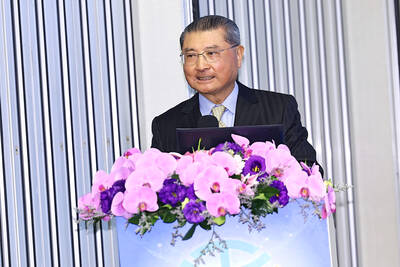Fixed-asset purchases, excluding land, by the manufacturing sector in the second quarter of this year rose 13.1 percent year-on-year, ending five consecutive quarters of decline, the Ministry of Economic Affairs said in a report on Tuesday.
The ministry attributed last quarter’s improvement to semiconductor companies’ accelerating the development of advanced-process technologies and the expansion of high-end packaging capacity to meet the strong demand for artificial intelligence and emerging technology applications.
Fixed assets include machinery, equipment, buildings and construction projects, as well as furniture, fixtures and vehicles.

Photo: Cheng I-hwa, Bloomberg
Battery and power equipment manufacturers’ capacity expansion in light of rising demand for green energy, grid resilience and power system improvements also contributed to the progress in last quarter’s fixed-asset purchases, it said.
The purchases rose to NT$482.2 billion (US$15.02 billion) during the second quarter from NT$426.5 billion a year earlier. On a quarterly basis, the second-quarter purchases increased 44.1 percent from NT$334.6 billion in the previous quarter, it said.
Meanwhile, total revenue brought in by the manufacturing sector, including overseas production, increased 8.1 percent annually in the second quarter to NT$8.03 trillion, reversing six consecutive quarters of negative growth, the report said.
Last quarter’s revenue grew 8.9 percent from NT$7.37 trillion in the previous quarter, it said.
Within the manufacturing sector, the electronic components industry posted the largest purchases in fixed assets in the second quarter, at NT$327.6 billion, the report showed.
The amount is a 26.3 percent increase from a year earlier and accounted for 67.9 percent of total purchases by local manufacturers in the quarter, it said.
The chemical materials industry was second in terms of fixed-asset purchases as firms spent NT$20.8 billion, but the figure was down 27.5 percent year-on-year, it said.
The metal, computer and optoelectronics industries, and oil and coal production also reported that purchases dropped 3.1 percent, 9.9 percent and 22.5 percent respectively from a year earlier, it said.
Nonetheless, the base metal, machinery equipment and power equipment industries increased purchases by 3 percent, 9.5 percent and 73.5 percent year-on-year respectively in the quarter, it said.
The manufacturing sector’s fixed-asset purchases in the first half of the year totaled NT$816.8 billion, down 6.3 percent from the same period last year, it added.
Looking ahead, semiconductor firms’ continued capacity expansion and the improving outlook for end-market demand, as well as firms’ growing interest in net zero, automation and digitization trends should continue to boost investment momentum in the manufacturing sector, the ministry said.
However, as external headwinds remain ahead such as the implications of central banks’ interest rate adjustments, US-China tech competition and geopolitical tensions, manufacturers should remain cautious about their capital spending, it said.

When an apartment comes up for rent in Germany’s big cities, hundreds of prospective tenants often queue down the street to view it, but the acute shortage of affordable housing is getting scant attention ahead of today’s snap general election. “Housing is one of the main problems for people, but nobody talks about it, nobody takes it seriously,” said Andreas Ibel, president of Build Europe, an association representing housing developers. Migration and the sluggish economy top the list of voters’ concerns, but analysts say housing policy fails to break through as returns on investment take time to register, making the

‘SILVER LINING’: Although the news caused TSMC to fall on the local market, an analyst said that as tariffs are not set to go into effect until April, there is still time for negotiations US President Donald Trump on Tuesday said that he would likely impose tariffs on semiconductor, automobile and pharmaceutical imports of about 25 percent, with an announcement coming as soon as April 2 in a move that would represent a dramatic widening of the US leader’s trade war. “I probably will tell you that on April 2, but it’ll be in the neighborhood of 25 percent,” Trump told reporters at his Mar-a-Lago club when asked about his plan for auto tariffs. Asked about similar levies on pharmaceutical drugs and semiconductors, the president said that “it’ll be 25 percent and higher, and it’ll

CHIP BOOM: Revenue for the semiconductor industry is set to reach US$1 trillion by 2032, opening up opportunities for the chip pacakging and testing company, it said ASE Technology Holding Co (日月光投控), the world’s largest provider of outsourced semiconductor assembly and test (OSAT) services, yesterday launched a new advanced manufacturing facility in Penang, Malaysia, aiming to meet growing demand for emerging technologies such as generative artificial intelligence (AI) applications. The US$300 million facility is a critical step in expanding ASE’s global footprint, offering an alternative for customers from the US, Europe, Japan, South Korea and China to assemble and test chips outside of Taiwan amid efforts to diversify supply chains. The plant, the company’s fifth in Malaysia, is part of a strategic expansion plan that would more than triple

Taiwanese artificial intelligence (AI) server makers are expected to make major investments in Texas in May after US President Donald Trump’s first 100 days in office and amid his rising tariff threats, Taiwan Electrical and Electronic Manufacturers’ Association (TEEMA, 台灣電子電機公會) chairman Richard Lee (李詩欽) said yesterday. The association led a delegation of seven AI server manufacturers to Washington, as well as the US states of California, Texas and New Mexico, to discuss land and tax issues, as Taiwanese firms speed up their production plans in the US with many of them seeing Texas as their top option for investment, Lee said. The